I have glass scales on the mill, and on the V13 I have the exact same magnetic scales as you have. Chips are not attracted to the scales.
Fantastic! Do you know if an external magnet can hurt the scales?
I have glass scales on the mill, and on the V13 I have the exact same magnetic scales as you have. Chips are not attracted to the scales.
Fantastic! Do you know if an external magnet can hurt the scales?
I'm not sure about that, but i don't think it would, unless maybe if you put the magnet right on the scale. I'm not willing to test that though
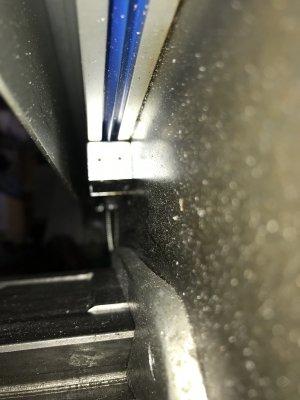
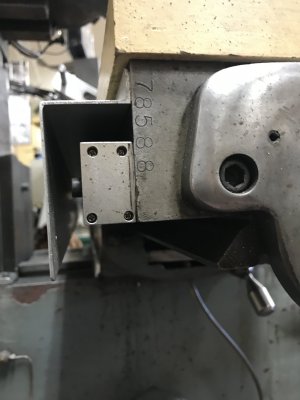
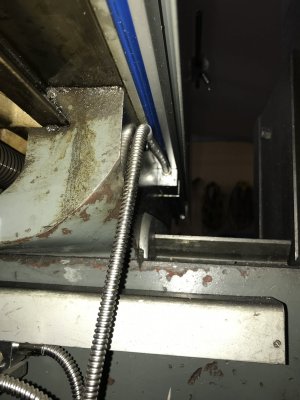
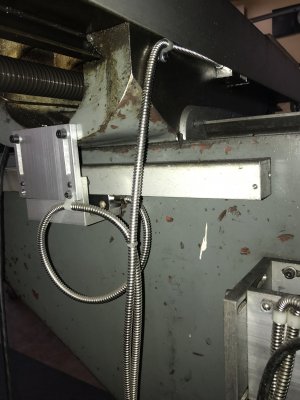




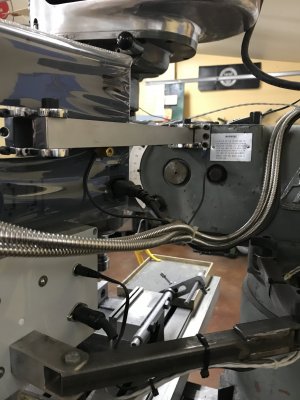

For what it's worth, here are a few photos of my 3 axis DRO installation. These are "old fashioned" glass scales installed quite awhile back. Please excuse the lack of cleanliness - just finished work on 3 cast iron cylinders for the current engine project and that stuff gets everywhere.
Fortunately the back of the table and saddle on my mill are vertical flats; certainly close enough to allow using just shims directly under the scale and read head to get things in alignment.
View attachment 21678 View attachment 21679 View attachment 21680
The Y scale is mounted to an aluminium bar/plate that is fastened to the knee. This allowed me to get the mounting plate true and plumb as required without fussing with the scale. Once all was good the scale could then be bolted to the mounting plate. A combination of angles and plates makes the connection between the saddle and the read head.
View attachment 21681 View attachment 21682
The knee scale (Z in my case) is also bolted to a mounting plate that is fastened to the mill column through a couple of standoffs. This arrangement took a lot of faffing about to get it right given that the standoffs are up against a curved casting and they are different from each other. It has proven to be an approach though. The read is connected through another series of angle brackets and plates so the read head is towards the rear of the mill for better protection from swarf.
View attachment 21683 View attachment 21684 View attachment 21685
The display is mounted to an arm that is bolted to the mill's head mount. Pretty straightforward. For good measure, I've included a photo of the quill scale. It is a "caliper-style" scale plugged into its own battery powered LCD display that is stuck to the mill's head with a magnet.
View attachment 21686 View attachment 21687
Enjoy your installation. Once you've used a DRO there is no going back to dials ... ever!
Do you grind in the shop?? If so the fine particulate metal will be attracted even 20 to 30 ft away.
How do you clean it, tape....
Enjoy your installation.
Do you grind in the shop?? If so the fine particulate metal will be attracted even 20 to 30 ft away.
How do you clean it, tape....
I just took a pinch of grinding dust from my surface grinder and tossed it at my magnetic scale. Some of it did stick, but not much. The reader heads do have wipers. Guarding against chips and dust is definitely a good idea, but keep in mind that you won't keep it all out, and you'll want to be able to clean. My mill has way covers which keeps the bulk of the chips off, but some always gets in. Way covers are easy to lift for cleaning, but a fully boxed in chip guard wouldn't be so easy.
Yes, we have the same DRO and the same scales. I don't think you'll have a problem mounting them in a conventional manner and adding some shields. You don't need to get crazy. Chips will get on them , not a big deal.And ya, mine have wipers too.
That happened to me at the metal scarp yard years ago when I was building the backhoe. I went there with my torches in the morning, and was like a fat kid in a candy store. ( I was a fat kid so I can say that). When I left around noon, the girl told me she thought I had left out the back way and had thrown my tare weight away. She asked me what my truck and trailer weighed....Ours is a rural dump, nobody cares what you do.
Once at the city dump i backed in next to a guy who was unloading a whole truck load of slat-wall sheets. I loaded it all up. On the way out, the girls in the scales were super confused because i was way heavier on the way out.
I was at coastal steel one time getting a large order, for me anyway. While waiting for it to get put together, I had coffee and shot the shit with the yard foreman. I asked him if i could raid the cutoff bin. He says, help yourself, don't get hurt. By the time i was done, I thought my tires were going to blowout. Truck and trailer were loaded from cuttoffs and my order. Nobody cared, but i felt special.That happened to me at the metal scarp yard years ago when I was building the backhoe. I went there with my torches in the morning, and was like a fat kid in a candy store. ( I was a fat kid so I can say that). When I left around noon, the girl told me she thought I had left out the back way and had thrown my tare weight away. She asked me what my truck and trailer weighed.........We came up to some mutually agreed upon number. I did not realize how long I was in there for.
When I got the mill it was missing the original handle/knob for the manual quill feed (the one used when the quill drive is engaged). What you see is the replacement I made.First question. Nothing to do with DROs (I think). What is that round handle to the left of your Quill dro in the last photo above?
No just a general question to make one think. Even tool sharpening causes enough ultra fine particles that get air born. Put a magnet somewhere in the shop and tape a white paper over it, look at it several months later, you'll be surprised how much is collected where the magnet is collected.Not sure who you are asking @Degen . If it is me, I do very little grinding inside. Mostly just tool sharpening. It hasn't been a problem. Not yet anyway. Maybe when I grow up.....
No just a general question to make one think. Even tool sharpening causes enough ultra fine particles that get air born. Put a magnet somewhere in the shop and tape a white paper over it, look at it several months later, you'll be surprised how much is collected where the magnet is collected.
If you do get a build up simple tape picks up the fine dust easily.
